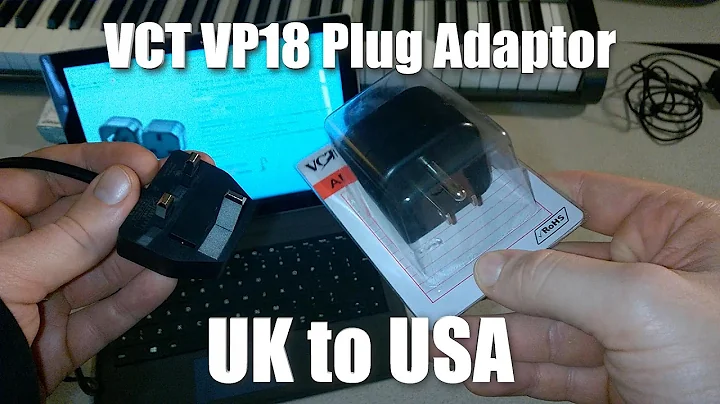Can I use an American AC cable for my European laptop adapter?
Solution 1
Yes you can, the IEC 320 C5 plug is standardized exactly for this kind of use case. The manufacturer only has to produce a single type of power supply, but can provide different cords for different regions.
Myself I have cables with IEC 320 C5 connectors for continental Europe, US, South Africa and UK and experience no problems at all.
Solution 2
Technically... it depends.
I gather that the OP here is starting from a 220 or higher voltage country, and thinking about travel to North America, where NEMA 5 connectors and 120 volts are common. (Or maybe Taiwan.) For that use case, helgso is on very solid ground. They're using a cordset rated for 125 volts with an outlet that supplies 120 volts max. Go ahead and plug right in. (Me, I'd just carry a plug adapter. It's less bulky than a second cordset.)
But people who are going the other direction, from North America to most other places, should read the following.
TL;DR version:
The "regulation" answer is: "No, you shouldn't. It almost certainly won't cause a problem, but you are exceeding the voltage rating on the NEMA - "North American" type - connector by plugging it into a 220 or higher outlet."
Yet, millions of travelers, including myself, do that exact same thing every day, without a problem. You won't have a problem either.
Details:
The issue is not the C5/C6 connector (nicknamed "cloverleaf" or "mickey mouse connector", btw) at the power inlet to the adapter, as addressed by mtak's answer. The issue is the voltage rating on the plug that goes into the wall, vs your local supply voltage.
Technically, legally speaking, you should only use a NEMA 5 (North American type) AC plug with a supply of 125 volts maximum, unless that plug and the cordset are specifically rated for higher voltage. Same for NEMA 1 (the two-prong, ungrounded version). And I doubt you'll ever find one like that. NEMA 1 and 5 plugs, and cordsets with such plugs, are simply not rated for higher voltages. The maximum is 125 volts (as it is on the OP's). This is part of the NEMA spec. NEMA has other connectors for higher voltages.
That does not mean that if you try to use them on a 240 volt outlet, things will necessarily burn up, arc over, or otherwise spectacularly fail! It's just that the plug isn't rated for it.
But technically, it's against the rules. In most countries it's even against the law. Even though plug adapters that let you do exactly this are sold in nearly every international airport.
So, if you bought your equipment in North America and you're traveling to any of the countries where the standard supply is significantly higher (220 to 240 volts - most of the rest of the world), the rules say you should not plug the NEMA 5 plug into a NEMA 5 outlet - unless you can confirm that the NEMA 5 outlet is providing 125 volts or less. It might not be. To comply with the standards, and stay within the tested margins, the cordset has to be rated for the supply voltage, right along with the device or power supply ("power brick") you're using.
( I've found many NEMA 5 outlets in airports and hotels, provided for the convenience of travelers from N.A., that are providing the local supply voltage even if that isn't 120. And of course, the simple plug adapters used by many travelers don't do voltage conversion either. )
But really, what could go wrong?
I know what you're thinking. "There should be no issues! After all your NEMA cordset will be handling only half the current that it would be at home, and isn't that what really matters? Sure, 240 volts can arc farther than 120, but isn't the plug spacing and the insulation and the general construction on NEMA 1 and 5 stuff more than enough to prevent arcs even at 240? Don't they have a safety margin in those "125 volt" ratings?"
And you'd be absolutely right on those points. The potential problems of using NEMA 125 volt-rated connectors on nearly that supply voltage are real. They're just subtle.
You may have noticed that plugging a laptop supply into 220 or more volts usually makes a larger spark in the plug contacts than plugging it into 120. That's because the higher voltage results in a higher peak current when it first charges the supply's capacitors. And if you happen to have been shocked by both 120 and 220, you'll know that you experience a FAR worse shock from the higher voltage, all else being equal. Well, the connectors in most - not all - non-NEMA countries are far better designed to prevent accidental contact with the plug prongs than are NEMA 1 or 5 connectors. They're also better at resisting pitting and etc. from those spikes upon initial connection.
And there is the potential for degradation over time, that can take a device that's not rated for 220 - but it works ok - into the unsafe region. A lot of power strips in the US are noticeably cheaply made, and if you open one you'll find gaps between live parts that are far narrower than the spacing between the plug prongs. After some amount of use, with the receptacles moving a little every time something is plugged in, along with wear and tear from frequent use and frequent travel, those gaps may become even smaller. My feeling is that these devices are considerably less safe at 220 than at 120. (They're not all that safe at 120 either, in my opinion. The US's enforcement of safety standards for these things is seriously underfunded.)
So what can we do about that, short of buying all new cordsets for our stuff?
First, you should check your cordsets for damage from wear and tear, particularly where the actual cord enters each connector. Replace them if you notice any.
If something besides the plug you're holding moves when you plug it into a power strip, replace that power strip!
Another easy safeguard is to use a power strip that includes its own fast-acting circuit breaker.
You can address the contact-pitting issue by plugging your NEMA 5 or NEMA 1 plug into your plug adapter first, then plug the plug adapter into the wall. The sparks will happen when the latter connection is made, to contacts that are presumably rated for the higher voltage. This also will likely make it more difficult for you to accidentally touch live parts while you're inserting the plug in the outlet (since in most countries, the higher-voltage side of the plug adapter will have safety provisions to that end).
And you said you do it? Use North American "125V" cordsets on 220-240V outlets?
Yes. On nearly every trip out of N.A. I bring a "plug adapter" that adapts my NEMA 1 and 5 plugs to the local supply outlets. I even bring a NEMA-type extension cord with a triple tap on it and plug several things into it. (Naturally, I don't carry anything that doesn't accept higher AC voltages as well as 120.)
If I look closely at my extension cord, and my cordsets, I'll find the "125V" rating embossed in tiny print on its plug and its sockets.
But (I will say again): millions of travelers (if not more) do this every day, and there are no rampant stories of fires or electrocutions as a result. It seems to be considerably more safe than, say, carrying a Samsung Galaxy Note 7 phone.
So despite all the cautions above, I'm not saying you will have a problem. I just think it's good to be aware of what's going on.
Hope this helps.
Related videos on Youtube
helgso
Updated on September 18, 2022Comments
-
helgso over 1 year
I am aware of a post on here that addresses if a laptop AC Adapter supports American voltage (100-120 volts), European voltage (210-230 volts) or both. However, that is not my question. I have this cable:
My question is: Can I buy ANY 3 Prong cable such as this one:
Plug it into my Lenovo 100-240V 1.8A 50-60Hz Input AC Adapter (see picture below) and use my charger like normally where there is an American plug even though the American cable is rated 7A 125V and not 2.5A 250V?
-
 mtak over 7 yearsAnother tip: buy another American cable and connect a European (or your local) 3 or 4 socket power strip to it. It's great to bring on business and you can use all your adapters from home (phone, tablet, ereader etc.) at the same time.
mtak over 7 yearsAnother tip: buy another American cable and connect a European (or your local) 3 or 4 socket power strip to it. It's great to bring on business and you can use all your adapters from home (phone, tablet, ereader etc.) at the same time. -
helgso over 7 yearsYeah, I've done that during vacation, it's a very nice trick. Thanks
-
 tripleee about 5 yearsFor what it's worth, a detail here bothered me. 240V mains is rather uncommon. Most countries have 220V (most of the EU and then some) or 230V. See also en.wikipedia.org/wiki/Mains_electricity_by_country (Of course, in many places especially in the third world, what actually comes out of the socket might also be quite different from the nominal standard voltage in the country.)
tripleee about 5 yearsFor what it's worth, a detail here bothered me. 240V mains is rather uncommon. Most countries have 220V (most of the EU and then some) or 230V. See also en.wikipedia.org/wiki/Mains_electricity_by_country (Of course, in many places especially in the third world, what actually comes out of the socket might also be quite different from the nominal standard voltage in the country.) -
Jamie Hanrahan about 5 yearsYou are correct of course. As a "NEMA native" I'm used to saying 240 for "the other voltage".
-
Jamie Hanrahan about 5 yearsFixed. btw, I think it's interesting how this has changed over the decades. The nominal, commonly-quoted supply voltage in N.A. used to be 110. Then it was 115, then 117, and now 120. btw most of Europe was 220 but has moved to 230 (see en.wikipedia.org/wiki/Mains_electricity#Standardisation ).
-
 tripleee about 5 yearsYeah, I wasn't aware we had switched to 230 in my country, too!
tripleee about 5 yearsYeah, I wasn't aware we had switched to 230 in my country, too! -
davidbaumann about 5 yearsYou really should add a tldr :)
-
Jamie Hanrahan about 5 years@davidbaumann Did that, and some reorg too. Better?










